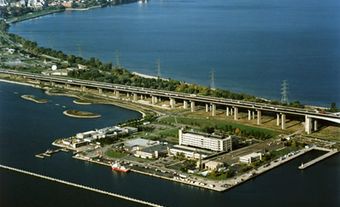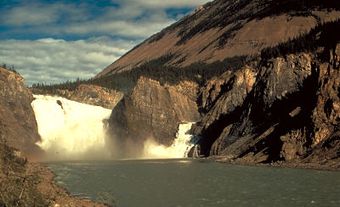
Groundwater
Groundwater is WATER which occupies the spaces between particles of soil and blocks of rock beneath our feet. Groundwater is ubiquitous; it can be found beneath the Great Plains, the Canadian Shield and mountainous terrain on both sides of the North American continent. Groundwater constitutes almost 70% of the world's freshwater supply. In comparison, LAKES and RIVERS make up only 0.2%, with the rest frozen in SNOW and ICE. Groundwater can dissolve soluble rocks and its circulation is responsible for the formation of CAVES in limestone terrain. Groundwater, heated at depth, often rises to the surface to form hot SPRINGS like those at Banff and Jasper, Alta, and Radium and Fairmont, BC.Hydrologic Cycle
Groundwater interacts with lakes and rivers as part of the hydrologic cycle. The cycle begins with the formation of clouds through evaporation from the ocean, lakes, rivers, plants and soil. Precipitation from the clouds either infiltrates as groundwater recharge or is diverted to lakes and streams as surface runoff. The proportion of infiltration versus runoff is dependent on the permeability of the soil, soil moisture, the amount of vegetation, topography and climate.
Infiltrating precipitation shares the interstices of the soil with air in the zone immediately beneath ground surface. At some depth the infiltrating water will encounter the water table. Below this surface the interstices are entirely occupied by water (no air present as a separate phase), and this is known as the groundwater zone. The region above the water table is known as the vadose zone.
Water in the groundwater zone is not stagnant and flows from regions of high water table to lower water table. In many cases, the direction of groundwater flow follows the topographic surface. Eventually, most groundwater will return to the surface of the Earth in areas of groundwater discharge such as wetlands, lakes and rivers.
The residence time of the percolating water in the vadose zone may be quite short (ie, hours to days), depending on the depth to the water table. Conversely, the residence time of water in the groundwater zone varies greatly and transit times as short as a few days to greater than 10 000 years have been measured. In some geological materials such as sands and gravels, or highly fractured rock, groundwater is plentiful and migrates at a rapid rate. These geological formations are known as aquifers and occur in various forms across Canada.
Groundwater as a Resource
In areas where groundwater is plentiful and easily pumped, such as the aquifers in the sand plains of south-central Ontario, the large sandstone aquifers in Alberta or the valley-bottom aquifers in New Brunswick, consumption for drinking water purposes is common. Groundwater is used as a source of drinking water by approximately 25-30% of Canadians. In some provinces, such as those in the Maritimes, the domestic use of groundwater is much higher. For example, the provinces of New Brunswick and Prince Edward Island are 64% and 100% reliant, respectively, on groundwater as a source of water for domestic use. Use in the prairie provinces ranges from 24% in Manitoba to 54% in Saskatchewan. In addition, 82% of Canada's rural population depend on groundwater for domestic use.
In addition to domestic use, groundwater is widely used in industrial and manufacturing processes and for agricultural purposes. For example, more than half of the groundwater consumed in British Columbia is done so for industrial purposes. In Manitoba and Alberta, the majority of groundwater usage is by the agricultural industry.
Because groundwater is an integral component of the hydrologic cycle, excessive consumption can adversely affect the sustainable use of surface water. Groundwater is a renewable but limited resource. For example, overconsumption of local groundwater combined with the effects of GLOBAL WARMING and of urbanization all negatively influence the groundwater component of wetlands ecosystems. In some areas of the country, development in rural areas is now limited by the sustainability (both quantity and quality) of groundwater supplies.
Groundwater Contamination
Since groundwater is an unseen resource and travels more slowly than the circulation of most surface water bodies (ie, centimetres to metres per year), groundwater contamination often goes undetected for extended periods of time. For example, some types of groundwater contamination, such as road salt, have yet to significantly impact surface water quality despite being present as groundwater contaminants for many decades. Unfortunately, groundwater contamination is often detected through the adverse smell or taste observed in water wells adjacent to the source of contamination.
The contamination of groundwater occurs through both point and non-point sources. Examples of non-point sources include road salt, agricultural chemicals, atmospheric deposition, land farming of industrial wastes and contamination from urbanization. The most common contaminants from these types of sources are chloride, nitrate and coliform bacteria. A survey conducted in 1992 of farm wells in Ontario found that 31% of the wells surveyed had levels of coliform bacteria above the maximum acceptable concentration (MAC), 13% had nitrate above the MAC and 8% had detectable levels of pesticides.
Point sources of contamination often result in elevated concentrations of contaminants that are more localized, and are more readily identified. Typical examples of point sources include leaking underground storage tanks, sites contaminated through industrial activity, landfills, subsurface waste injection, mining activities, large-scale chemical spills which occur through road or rail accident and a myriad of lesser sources. An example of a lesser source is the careless disposal of old gasoline used for lawn mowers, etc. As small an amount as a single litre of gasoline can render 1 million L of water undrinkable.
In recent years, contaminated industrial sites and landfills have received much public attention. At many of these sites, groundwater becomes contaminated by way of dense non-aqueous phase liquids (DNAPLs). These are often mixtures of organic (and sometimes inorganic) compounds that do not mix well with water and have a density greater than water. Dry-cleaning solvents are a good example of a commonly found DNAPL. Clean-up of sites contaminated with DNAPLs has proven to be costly and ineffective. In Canada, sites contaminated by DNAPLs are only now being discovered and the cost to remediate these sites has yet to be estimated.
Management of Groundwater
Management of groundwater as a resource was ceded to the provinces in the CONSTITUTION ACT OF 1867. Thus, authority to manage groundwater resources resides in provincial ministries. In practice, however, regional levels of governments often play a large role in regulating the use of groundwater through restrictions on consumptive use and industrial development. The federal government maintains a role in conducting research and providing advice to the provinces on matters related to groundwater contamination and consumption.

 Share on Facebook
Share on Facebook Share on X
Share on X Share by Email
Share by Email Share on Google Classroom
Share on Google Classroom


